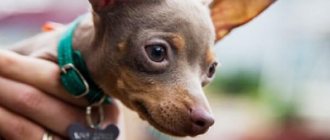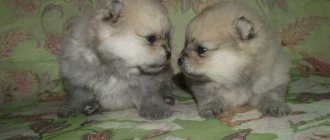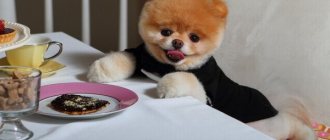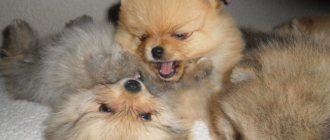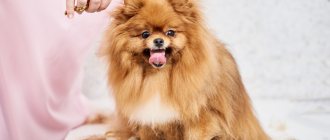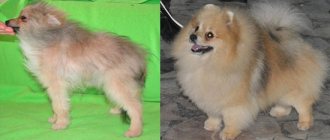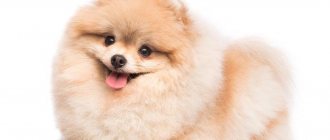If you love energetic, playful, loyal and incredibly beautiful dogs , then the Pomeranian is just for you. This small fluffy creature, which is also called a dwarf Spitz, loves attention, is easy to care for, and can be trained and educated. He will become an excellent friend and faithful companion to a child or an elderly person.
Character and temperament
Spitz are springs that are always active and cheerful. There is no need to wind them up; they will play and have fun all day long. We can say that these animals never lose heart.
Due to hyperactivity, children sometimes become uncontrollable.
Another negative trait of the breed is stubbornness. Spitz dogs do not resist out of malice, but because they do not want to waste time on training when it could be spent with other dogs or doing something else interesting. Therefore, training a Pomeranian should resemble a game.
Interesting! A well-trained Spitz restrains its emotional impulses in order to please its owners.
Health and illness
The history of the Pomeranian Spitz suggests that dogs of this type have undergone long-term selection . This gave rise to diseases typical of the breed. They are mainly associated with short stature.
Don’t be afraid of this; if you monitor your pet’s condition, care for it properly, and immediately contact a veterinarian when the first symptoms occur, you can easily avoid serious complications .
Lifespan
By dog standards, Pomeranians are long-lived , on average they live 12-16 years .
Tendency to diseases
Often four-legged animals have problems with joints, frequent dislocations, sprains .
Diseases of the digestive system are also a concern . They have a big appetite and are prone to obesity , so watch the frequency of feedings and do not treat them with food from the table.
problems arise , spasms of the larynx provoke a cough. The eyes, especially bulging eyes (which is a defect of the breed), are often prone to tearfulness and inflammation, especially in windy or hot weather.
Bitches have difficulty giving birth naturally . If you decide to breed oranges, consult with specialists before mating so that, if necessary, they can provide timely assistance.
Basic rules of training
The first condition is that the Spitz should be trained by a person who can be strict.
The second condition for effective training is that the puppy must not be pampered and even minor pranks and antics should not be allowed to get away with it.
Wrong behavior should be suppressed, correct behavior should be encouraged. In addition, there are other rules that will help make training more effective:
- Train when the puppy is not tired, but has just slept, recently eaten and is ready to play.
- Spitz remember emotional tone better than words.
- There is no need to skimp on treats, but treat your pet only according to its merits.
- If the Spitz is distracted, it is better to wait and start over.
How long to train
The only answer to the question: “How much training is needed?” – until the dog remembers the command. Repeat until the execution is brought to automaticity.
When training a simple command that does not require energy expenditure from the pet, it can be repeated 3-4 times a day. Serious commands, for example, “fetch”, which can be called an exercise for all muscle groups, 2-3 times a week, so as not to load the baby’s hind limbs.
The duration of each training session for a puppy should not exceed 10–15 minutes. The baby won't be able to stand it any longer; attention will begin to dissipate.
Rewards and punishments
The carrot and stick principle works for dogs too. Spitz dogs are great for the motivational method of training; they are ready to do anything for treats, praise and toys.
Correctly executed commands and good behavior are a reason to reward with tasty treats.
Punishment includes a stern look, a harshly pronounced nickname, deprivation of toys, treats, or even one meal.
The main condition is that the Spitz understands why he received the scolding.
Important! The dog should not be beaten, called names, or scolded loudly during training. This will only cause aggression. As a last resort, you can click the Spitz on the ear.
What should be prohibited
Spitz are decorative dogs that are unfairly classified as “couch soft toys.” In fact, these dogs are active, restless and disobedient, and require serious training, competent education and restrictions.
First of all, the owner must prohibit the puppy from gnawing and damaging things and furniture. There are toys for this.
Secondly, there is a taboo on sleeping with a person. The Spitz is allowed to sleep only in its house or on a lounger.
The third prohibition is begging. Any attempts to beg for a piece should be ignored.
Important! A few more conditions for getting a well-mannered dog: the Spitz should enter the room only after the owner, eat only when the whole family has left the dinner table, ask to go for a walk when the main time for walks comes.
Description of the breed
Pomeranians have characteristic features that set them apart from other species. This is a small dog with a small neat muzzle, reminiscent of a fox, small button eyes and a somewhat elongated nose.
Standards
The main proportions of a Toy Spitz are the ratio of body length to height from the withers to the floor 1 to 1, the ratio of the skull to the muzzle 4 to 2.
Head
- There is a wedge-shaped narrowing of the head towards the nose.
- Small black or dark brown nose.
- Black lips close to the jaw, without folds.
- Scissor bite or straight bite.
- The eyes are dark, almond-shaped, and set slightly askew.
- The ears are pointed, small with a hard tip, close to each other.
Torso
- The back is straight and short.
- The croup is not sloping.
- The chest is deep.
- The stomach is tucked.
- The tail fits tightly to the back, curled upward from the base.
Limbs
- The shoulder blades form a right angle with the shoulder.
- The front legs are round and short, the toes are compressed.
- The hind limbs stand parallel.
- The pads are hard and dark.
Wool
The Pomeranian has a short, dense undercoat and long, straight hair . The head, ears and front sides of the limbs are covered with short, smooth hair. A thick mane adorns the shoulders and neck .
Colors
There are different types of colors, with a total of about sixteen . The final color of the four-legged coat appears after molting, at six months. They also reach their maximum size at this age.
Red dwarf Spitz have become the most popular and widespread , although there are also cream, brown, black, white, and two-colored individuals. The white Spitz was one of the last to appear, since it is difficult to breed a breed of pure color without impurities . The same applies to black color. It is necessary to take into account the color of the dogs and their ancestors so that there are no unexpected impurities in the litter.
White : The coat is perfectly white, with a possible hint of yellow on the ears.
Black : The coat is pure black. The undercoat is dark to match the skin color.
Brown : The coat is evenly colored, dark brown.
Orange : The coat is uniformly colored, with lighter shades possible on the tail and chest.
Wolf Grey : Silvery gray with black tips. The muzzle and ears are dark, with a graphic pattern around the eyes.
Spotted : Solid colored spots are placed on a white background.
Character
Smart, playful, friendly and sensitive dogs, wonderful companions and loyal friends . They love children, but you should not leave them with babies, they can accidentally harm the dog. Despite its small size, an adult pet considers itself a big dog and often fights with animals that are much larger in size.
Speaking about the Pomeranian, it should be noted that by nature they tend to dominate . Dogs of this type consider themselves masters of the house and will not tolerate a stranger , even if he is much larger and stronger. It is important to cultivate the pet’s character, not to spoil them; they sense the slightest mood swings of the owner and react to reproaches or praise. very attached to their owner and are ready to protect them at the slightest danger.
There are also disadvantages in the characteristics of the breed, the main ones being the loud and sonorous constant barking , it quickly tires and even irritates, especially strangers who are not accustomed to this. Education and regular training will help to cope with this feature.
When to start training
Dog handlers are still debating about the age of dogs and when to start training. Some people believe that the younger the Spitz, the easier it is for him to remember commands.
Others are sure that small dogs are absent-minded, often distracted, cannot concentrate, and therefore difficult to train.
One way or another, there is one general rule - they begin to raise and train a puppy from the first days of arrival in the apartment. And tricks can be taught later: at 3–12 months.
For training each team, there is an ideal puppy age when training is most effective.
Do Pomeranians get sick often?
Every potential owner of a dwarf Spitz is interested in what health problems the dog may have at a young age and as it grows. The Pomeranian is distinguished by good health, since the breed was created artificially and breeders did painstaking work to obtain individuals with strong immunity. Spitz are distinguished by a long life expectancy - 12-14 years, some individuals become old-timers, living 15-17 years.
Most diseases of toy dogs are associated with their miniature size. You should carefully monitor your small pet in order to promptly notice deviations in behavior, which are the first signs of pathologies. For their prevention and prevention, deworming, vaccination, regular visits to the veterinarian, careful care and proper maintenance of Pomeranian Spitz play an important role.
Where to start training
While the Spitz puppy is small, he cannot perform complex tricks and physical exercises, but now is the time to develop his intelligence.
First of all, a dog needs brain training; the simplest exercises can be done at home.
First of all, the little Spitz must remember its name, then it will be easier to train and the lessons will be more effective.
Important! A Spitz puppy will obey during training when the owner proves his leadership by constantly showing rigor, punctuality, consistency in actions, confidence and patience.
Remember the nickname
A Spitz should remember its name at 3–4 months. The more often the owner calls the pet’s name, the faster the dog will learn it.
It is recommended not to use other names, affectionate nicknames and diminutive forms - only the full or abbreviated name that is used in everyday life.
The puppy is called by its nickname for a walk or meal, while playing or to attract attention. To be effective, they lure with a treat or toy, while calling the name loudly and clearly.
Toilet training a puppy
The puppy is toilet trained from an early age. When the baby enters the house, it is recommended to cover the entire floor with diapers, after removing the carpets. It is better to limit the space for the Spitz to an enclosure, an arena, or at least one room.
After 3-4 days you can leave 2-3 diapers. If you plan to toilet your Spitz at home, it is better to immediately install the tray in a convenient place and cover it with one of the marked diapers.
After completing the first course of vaccination, they begin walking. It is necessary to take the baby outside after every meal and sleep: at this time the dog wants to go to the toilet. It is recommended to walk for no longer than 10–15 minutes, during which time the Spitz should do its business.
When the puppy grows up and begins to communicate with other dogs, he will see that his brothers go to the toilet on the street and will try to imitate them. After each “success” the Spitz is praised and treated. Puddles in the house are punishable.
Features of puppy socialization
Socialization is an essential part of training, which will help the Spitz establish contact with the outside world. An unsocialized pet will grow up to be either fearful or aggressive.
After the veterinarian has given permission for walking, the Spitz is taken to quiet, calm places where he can “feel” nature. After 2-3 days, you can take a walk with him in an uncrowded park. The next stage is getting to know the dog park.
At first, it is better to go out during the day so as not to run into a whole pack of unfamiliar pets. When the baby gets used to it, it is good to continue training in the company of other dogs.
Next, the Spitz is introduced to the noisy streets, while being kept only on a leash. If the puppy gets scared, you can pick him up. An additional workout will be a trip on public transport.
What to do if your Pomeranian is crying?
Pomeranians have a peculiarity - their eyes run very often. Tear tracks appear, which are especially noticeable on light-colored fur. Before seeking help from a veterinarian, it is worth observing and finding out the cause of the lacrimation. It could be:
- long hair around the eyes;
- flaws in nutrition;
- unfavorable weather conditions (wind, heat);
- dust, pollen;
- allergic reaction;
- injury;
- diseases.
If the dog is healthy, its eyes are clear, clean and shiny. When there is no pus, but only occasional tears are released, this is normal. Perhaps fur or eyelashes are getting into the eye and irritating it. If the volume of discharge increases, it is necessary to take measures - cut off the hair near the eyes using safety scissors, wipe daily with a cotton pad soaked in boiled water.
When swelling of the eyelids occurs, use Chamomile eye lotion with an antimicrobial effect.
When watery eyes are caused by the wind, special eye drops that are instilled immediately before a walk will help.
Eyes often water because of the presence of sweets in the Pomeranian's diet. By analyzing the menu and excluding prohibited foods (sweet, fatty, fried), you can achieve the desired result.
If the dog continues to cry, you should consult a doctor, since the cause may be more serious - inversion of the eyelids, inflammation of the lacrimal sac. In this case, serious treatment of the disease and possibly surgery will be required.
Command training
Almost all commands for dogs are not just entertainment, but signals for control and control. Without their knowledge, the Spitz will not be obedient, and this can lead to an accident. Commands allow you to control your pet’s behavior indoors, in crowded places, in transport, during hygiene procedures, and examinations.
It’s a good idea to start training a small puppy at home - training with the owner will not cause him stress. And the schemes and recommendations developed by dog handlers will help you teach your Spitz commands.
To me
Take the dog on a leash, walk away its entire length and say the command “Come to me!” The Spitz did not pay attention to this - lightly pull the leash and lure the dog with a treat. Repeat until the puppy comes up without tugging on the leash.
Near
This command is necessary for a safe walk in crowded places. Command “Near!” and pull the leash towards you, bring the puppy to your leg. Spitz tries to speed up and moves away - repeat the command and algorithm of actions. Encourage obedience.
Sit
A classic static command, mastering it is a prerequisite before moving on to complex tricks.
Stand at the side of the Spitz at a short distance, take him on a leash. Say the nickname and the command “Sit!”, and then gently press on the lower part of the lower back. Pull the leash up and away from you. Be sure to praise the animal for correctly following the command.
The second training option: kneel in front of the Spitz, raise a treat over it, and order “Sit!” and press lightly on the croup. Then give your pet a treat.
Place
A mandatory command that allows you to quickly calm the dog down and send it to bed. The Spitz already has a small house or a personal corner. Say the command “Place!”, point to the bed and take the baby to it.
The second option: stand near the lounger, raise a treat over it, call the Spitz by name and say “Place!” After the dog jumps onto his bed, give the treat.
You can't (Ugh)
This is a mandatory signal that must lead to action. The command is pronounced strictly and once. If the Spitz does not listen, he is punished.
Team training goes like this. Offer and feed your pet a piece of treat. After a minute, show the same one, holding it tightly with your thumb in your palm.
When the Spitz wants to take him away, say “No!” or “Ugh!” and click the dog on the ear. You need to achieve such an effect that, on a signal, the puppy turns its head away from the hand.
Give
While playing, give the Spitz something to grab; it’s more convenient if the toy is a rope. After a while, look sternly at the dog and say “Give!” Pick up the item. As soon as the baby gives up the rope, praise him, give him a treat and return the toy.
If the dog does not give up, slow him down a little, repeating the command strictly. You cannot pull the rope; the Spitz will only clench its jaws tighter and begin to get angry.
Quiet and voice
These two commands are studied in pairs from about 2 months. When the puppy starts barking, for example, during play, repeat “Voice!”, “Okay, voice!” several times. and give a treat.
The puppy continued to bark - say “Quiet!” and squeeze his mouth with your hand, then give him a treat.
Lie
Training for this command begins at 3 months. Command “Sit!”, wait for execution. Say “Lie down!”, pressing on the withers with one hand, and lowering the treat to the ground with the other so that the Spitz reaches for it. After following the command, allow him to eat the treat.
Stand
Not the most favorite command for Spitz dogs, because it is associated with hygiene procedures and inspection. It is not necessary, but helps during grooming and veterinary appointments.
When the Spitz is sitting, go up to him and say: “Stop!” At the same time, support the puppy under the belly with one hand, and pull the collar with the other.
When the dog gets up, praise him and give him a treat. It is important that he does not take unnecessary steps.
Give me your paw
One of the simple “entertaining” exercises. It is done like this:
- put a treat on your palm and let the spitz sniff it;
- hold the treat in your fist and raise it to the level of your pet’s nose;
- when he tries to tap your hand with his paw, open your palm, say: “Give me your paw,” and feed the treat to the dog.
Aport
This command is the most fun and interesting for Spitz, but they begin to study it when the baby reaches 6–7 months and knows the “Near!” signals. and “Come to me!”
The first step is to teach the dog to take the thing, hold it and give it back on the command “Give!” Tease the Spitz with a stick or other inedible object, when he tries to grab it, say “Fetch!” and allow to take, encourage.
Then wait 3-5 seconds, say “Give!” and pick up the item and treat the pet with a treat.
The second step is learning to walk with an object in your teeth. When the Spitz grabs the wand, take a few steps away from him and call “Come to me!” or “Nearby!” Repeat the manipulation with the command “Give!” and praise the dog.
The last stage is to teach how to lift an object. Take the Spitz on a leash and throw the object so that it is in the animal’s field of vision. Command “Fetch!”, lead to the object, point at it and repeat the command again.
If the dog does not react, move the object. As a last resort, give it to your pet’s teeth. Then repeat the command “Give!” and give the baby a treat.
Bow
A Spitz can learn this optional command after a general training course. It is not functional or important, but develops coordination and thinking.
Stand in front of your pet, lower the treat to the ground and invite the dog to take it. When the Spitz tries to bend over or lie down to take the treat, place your other hand under his belly and say “Bow!”, and then give him a treat. Repeat until the Spitz understands that it is forbidden to lie down.
Pomeranian treatment
Most often, Pomeranian diseases are treated not in a veterinary clinic, but at home, so the owner must know how to carry out the procedures.
To give a dog liquid medicine, it is drawn into a syringe without a needle, inserted between the teeth in the mouth and pressed on the plunger. The powder is mixed with minced meat and fed to the Pomeranian. The tablets are placed in the pet’s mouth as close to the throat as possible, the mouth is closed and the top is lifted so that it swallows the medicine.
Injections are given in the withers or thigh. Use insulin syringes with a thinner and shorter needle.
In case of poisoning, they act according to the situation - if four hours have not passed, wash the stomach and give a sorbent. Otherwise, this cannot be done, since the poison is already in the intestines. You need to give a laxative, give a vitamin K injection, an enema and take the Pomeranian to the veterinarian.
If vomiting persists, pills will not help; your pet needs to be given something to drink to avoid dehydration and then shown to a doctor.
To stop diarrhea, you should change your diet, feed rice porridge, broth, and meat. To improve digestion, enzymes and special additives are added to the feed. If there is blood in the stool, the dog is taken to a veterinary clinic.
If your dog has sprained a ligament or suffered a bruise, it is necessary to reduce activity and stress during walks. The cut is treated with an antiseptic and bandaged. The fracture is fixed with a splint and the dog is taken to the doctor.
How to stop biting
Puppies during the period of changing teeth (3-4 months) are looking for something to bite. And, usually, they choose the legs and arms of the owner. But this behavior will become a habit and subsequently will no longer be funny if the Spitz is not weaned from biting at an early age.
First of all, the baby must understand that human body parts are not a toy. Therefore, when the dog wants to bite someone, offer him a ball or a squeaker.
When a puppy bites his fingers not on purpose, but out of interest or boredom, it is better not to pay attention to it, but not to give him a reason to behave this way next time.
There are developed training schemes that help to wean a Spitz from biting.
- When the puppy is calm and well-fed, hold your hand in front of his muzzle. If the baby does not react, he should be praised and treated with a treat. Otherwise, pull your hand back and sternly say: “You can’t!” The training is carried out 2-3 times daily.
- If your Spitz wants to bite, hide your hands behind your back. When he calms down, snap your fingers in front of his nose and give him a treat. Repeat several times.
How to choose a puppy
The choice of a Pomeranian Spitz puppy should be taken responsibly . It is better to buy a puppy from a kennel, so you will be sure of its good pedigree.
Puppy cost
The cost of a Pomeranian Spitz reaches 60,000 rubles and depends on the class and gender of the dog and pedigree. A pet without documents can be purchased for less than 15,000 rubles .
What to look for when choosing a puppy
When choosing a puppy, pay attention to the state of health , if necessary, consult a veterinarian. When buying a baby with documents, also ask for documents for the parents .
If you don’t know what to name your Pomeranian puppy , read the article with a huge number of nicknames.
These incredibly beautiful, charming, smart and devoted dogs will become favorites of your entire family and will certainly not leave anyone indifferent. It’s not for nothing that they are so loved by tens of thousands of people around the world, including world celebrities.
Video “Pomeranian Spitz - everything about the breed”
How to stop barking at home
Stopping a Spitz from barking at home is one of the most difficult training tasks. Constant barking for no reason is a feature of the breed. You need to teach your pet basic commands to make it easier to control it.
It is recommended to avoid noisy entertainment (with a tambourine, rattle, loud squeakers), and arrange a place for the Pomeranian away from the front door. The baby needs to be given enough attention so as not to make him sad.
Important! A dog barks when no one is home, which means she is bored. It is recommended to leave the radio on and close the windows and curtains.
How to care for a sick dog?
If a Pomeranian is sick, its body becomes very vulnerable, so maximum attention should be paid to its diet. Food should be healthy, nutritious and well digestible. At the same time, they monitor caloric intake so that the problem of obesity does not arise. Excessive body weight can provoke other disorders in the functioning of organs and systems.
During illness, it is important to adhere to the drinking regime. Clean and fresh water should be available to your pet at all times. If he gets sick and the body does not receive enough fluid, the development of kidney failure, exacerbation of urolithiasis, thickening of the blood, changes in the condition of the mucous membranes, the appearance of the coat and skin are likely.
The dog cannot complain of fever, nausea or weakness, so it must be constantly monitored in order to notice changes in its condition in time.
A veterinarian is contacted when one or more symptoms of the disease appear:
- seizures;
- bowel disorders;
- fever;
- lethargy;
- loss of appetite;
- problems with urination and bowel movements;
- thirst;
- gait changes;
- pain when moving.
All doctor’s instructions are strictly followed, observing changes in the pet’s condition. The Pomeranian Spitz should not be left unattended, and if new clinical signs of disease appear, the dog should be taken to a veterinarian.
How to train a Spitz to be alone
Spitz are one of those breeds that cannot be ignored by their owners. But in city life, the pet has to stay at home alone. Teach him to be independent from an early age so that the dog feels comfortable alone.
You can leave your dog alone at home from the age of 3 months, while limiting its space. They purchase spacious playpens (for children or special ones for dogs) or simply block the passages to the rooms.
Next to the puppy you need to place a bowl of water, toys, a diaper - a home toilet and a lounger. It is better for the baby not to sit on his own for longer than 2–3 hours.
What diseases can a low-weight Spitz have?
Pomeranian puppies are born small. Their weight depends on the size of the parents, but most often the average weight of babies is 70-170 g. At first they develop normally, then the speed slows down. Such Pomeranians have large fontanelles. They do not last long, and in some individuals the bones may not come together, which is a defect from the point of view of the standard.
Veterinarians believe that the prognosis for development is extremely unfavorable in Spitz dogs whose height is less than 18 cm. Dogs (especially girls) have too thin bones, which makes them unsuitable for breeding and participation in exhibitions. These Pomeranians have bulging eyes, a weak nervous system and other diseases. When purchasing a puppy with a small body weight, you need to be prepared for regular visits to the veterinary clinic and long treatment.
Recommendations from dog handlers
Spitz are always puppies, they love to play and have fun, so getting them interested in training is not so easy. But dog handlers know how to solve this problem:
- Training should be turned into a game using treats, attributes, and obstacle courses.
- The duration of one exercise is no more than 10 minutes; the more often the Spitz’s attention is switched, the longer he will listen; To consolidate, it is better to return to the exercise at the end of the workout.
- Each individual requires an individual approach. Usually animals are better trained in a group, but some Spitz puppies get lost in the company of other pets and cannot concentrate.
- When a Spitz does not understand or does not want to follow a command, you cannot hit or shout at it; it is better to repeat the exercise again.
- The dog should not be overtired; it is better to train it an hour after eating and walking.
How to teach your Pomeranian commands and tricks yourself?
First of all, a small Spitz puppy should be taught prohibitive commands, and only then can you proceed with the rest. Two main prohibitions: “Ugh!” and "You can't." They are trained with food or toys. You need to place a tasty morsel or ball close to the dog or hold it in your hand. This is followed by a prohibition command. Reward is given only after the pet stops reaching for food or a toy.
Pomeranian Spitz training:
- The “Give” command is taught using something. When a pet approaches its owner with a toy in its mouth, a command follows and the person carefully removes (does not pull!) the object from its mouth.
- The order “Come to me” is taught through food. The owner holds the piece in his hand, pronounces the command and rewards the pet after it is completed.
- The “Place” command is first performed by the owner instead of the pet. The puppy is picked up and carried to the bed, repeating the command. If the dog remains on the bedding, he is rewarded.
- “Voice” is the easiest command for a “talkative” dog. The owner raises the treat higher, but does not give it to the puppy until it barks.
It is better to learn complex commands under the supervision of a dog handler, especially if the owner is a novice dog breeder.
How to play with a Pomeranian at home?
Pomeranians are playful by nature, and a well-trained pet also clearly understands when to play and when to leave the owner alone. Lesson options:
- wrap a tasty piece in a napkin or handkerchief and invite the dog to get it himself;
- hide the food in a drawer in front of the dog, close it loosely and allow the dog to get a piece;
- tie a piece of fairly dense food (for example, a pig's ear) to a long string and push it far under the furniture, inviting the dog to pull the food out by the rope;
- leave the pet alone in the room, close the door loosely and call the dog (he must cope with the obstacle on his own).
You can train your Pomeranian to jump through a hoop or jump rope, overcome a “scary” tunnel made of a blanket on stools, or fetch a toy.
Content
- The main character traits of a Pomeranian: female or male?
- Character of the Pomeranian Spitz
- Basic commands
- Raising a dog
In this article you will learn what features of character and behavior are inherent in the Pomeranian Spitz. After studying this information about the temperament and disposition of the Pomeranian Spitz at different ages, you will get an idea about the breed. Find out how the character of a bitch differs from the behavior of a dog. We hope our article will help you figure out which gender of puppy is best for you.
Tips for care and training
A well-bred Pomeranian Spitz will not cause big problems in its maintenance. Caring for your pet consists of regular brushing, brushing teeth and ears, trimming nails and bathing. It is better to entrust monitoring of the condition of teeth to a veterinarian. Brushing can be turned into a kind of ritual, at the end of which the dog receives encouragement. You can trim the nails yourself, but for the first time it is better to watch a professional work. Bathing your Pomeranian completely is not recommended, especially during shedding. The maximum “water procedures” is washing your paws after a walk.
In some cases, care and training can be combined. For example, when a dog first arrives in the house, you can spread several diapers around the dog's toilet. As soon as the puppy goes to one of them, it is transferred to the tray and left until the next time. If he again goes somewhere to the side, a new soiled diaper is transferred to the tray. The number of diapers is gradually reduced, removing those that remain clean.
The main commandment of training is the same law for everyone and for all times. You cannot indulge your pet, even if he is sick. Proper upbringing shapes character:
- a trained dog follows the command the first time;
- the dog must know that the owner will stroke and praise him only for good behavior;
- At the beginning of training, the Pomeranian Spitz should be addressed only by name, no “babies”, “fluffies” or other words that the dog does not understand.
Cruelty, constant yelling and scolding are a bad choice. They begin to teach with the simplest concepts and gradually increase the complexity of the tasks. Ideal conditions are required (no irritating or distracting factors). All commands are pronounced in a confident tone that does not allow for objections.
